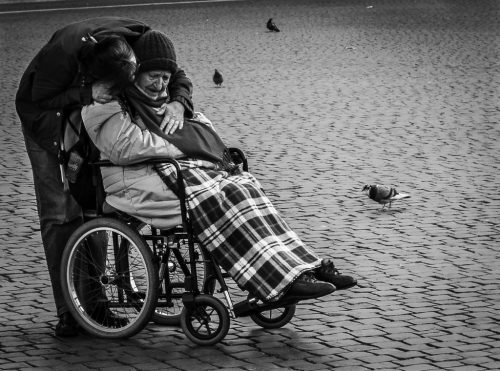 The first question my supervisor always asks me when I am discussing with her someone that I’m working with is: “What gets them out of bed in the morning?” Sometimes she rephrases this as: “What might get them out of bed in the morning?”
The first question my supervisor always asks me when I am discussing with her someone that I’m working with is: “What gets them out of bed in the morning?” Sometimes she rephrases this as: “What might get them out of bed in the morning?”
There are other variants to this question: “What is [this person] about?” or “What is it that [this person] wants to get from therapy for his/her life?”
This might surprise you. You might expect her question to be more formal, along the lines of: “What is the presenting issue?” (i.e. what kind of suffering or struggle – anxiety, depression, relationships) does [this person] feel is getting in the way of the life they wants to be living. And that question gets asked too. But perhaps you can see why we need to know what the hoped-for destination is first before thinking about the obstacles that come up for us when we start moving towards the things we most want for and from our lives. These also become, by implication, the things we want “therapy” to give us (from the Greek therapeia ‘healing’; also Old English hǣlan ‘restore to sound health’, or ‘whole’).
Sometimes I have to say in response to this question that I’m no longer sure where we’re heading, that both myself and my client have lost sight of the main thread of our sessions and are mainly in firefighting mode: tackling issue that have arisen in the last week, trying as best we can to make sense of them in 50 minutes available to us, often frustratingly running out of time as we valiantly struggle with the fire that’s causing or threatening to cause havoc or mayhem, that moment when the incidents of one’s life seem to have become something of “an emergency”.
There certainly needs to be space in any therapy journey for this kind of firefighting. But we can often lose sight or sense of the shape of the journey itself when therapy and one’s own life is concentrated primarily on firefighting.
When I admit to my supervisor that I’m no longer sure what route we’re on, she nods sagely and murmurs “therapist drift“, because that’s the technical term for this situation. We both smile. I don’t take it as a criticism (although it could be) because we talk often about this phenomenon. And it’s really not a problem as long as we we know how to get back on track.
THERAPY AS A JOURNEY
 Thinking of therapy as a journey is a handy analogy. Imagine heading out on a ten mile hike, as I often do on the weekends. One of my favourite routes, also because it is so close to where I live is Chorleywood to Chesham. The destination of this hike is, as the name would suggest, Chesham!
Thinking of therapy as a journey is a handy analogy. Imagine heading out on a ten mile hike, as I often do on the weekends. One of my favourite routes, also because it is so close to where I live is Chorleywood to Chesham. The destination of this hike is, as the name would suggest, Chesham!
If you’re not familiar with the route, undoubtedly you might get a little bit lost on the way, or have to make a detour because of some bulls in a field. You might even be waylaid at some point because of a troubling phone call that gets you walking round and round the same field ten times in a daze, wondering if you should perhaps just call the whole thing off and head to a pub instead.
But as long as you know and keep your destination in mind, the route will gradually take you (us, if I’m walking in some capacity besides you) in the direction of where you want to be heading, and the “you” you want to be heading towards on arrival. We will get there in the end, even if delayed in various ways along the way. But we will get there only if we have some kind of meaningful destination to move towards, and a reason for getting there. My reason for getting to Chesham is usually that I can then feel good about having done my ten miles, and reward myself with a slice of carrot cake from Costas (good carrot cake at Costas Chesham btw).
How do we work out your route? I use two main orientation tools: Life-Goals and Yearnings.
LIFE-GOALS
 Life-Goals sound very grand, but I have yet to find a term that sums these up more diminutively. I do think we need to bring in the word “life” here however, denoting as it does, a whole span of living: Shakespeare’s Seven Ages or whatever paradigm you use to parse out the different stages of human life. Thinking about our Life-Goals forces us to consider The Big Picture, and this can be useful when we’re getting tangled or lost in some of the smaller-picture side-routes, those challenges in life that we encounter as we proceed along its highways and byways.
Life-Goals sound very grand, but I have yet to find a term that sums these up more diminutively. I do think we need to bring in the word “life” here however, denoting as it does, a whole span of living: Shakespeare’s Seven Ages or whatever paradigm you use to parse out the different stages of human life. Thinking about our Life-Goals forces us to consider The Big Picture, and this can be useful when we’re getting tangled or lost in some of the smaller-picture side-routes, those challenges in life that we encounter as we proceed along its highways and byways.
There’s that old adage that nobody on their deathbed wishes they’d spent more time at the office. Or worrying for that matter. Or even: “dealing better with worry (anxiety), depression, or low self-esteem”. Often our minds tell us that THIS IS WHAT YOUR LIFE NOW NEEDS TO BE ABOUT BEFORE YOU CAN DO THE THINGS YOU WANT TO DO! But that is rarely the case.
Often these are short-term, firefighting goals. Only firemen, and the occasional firewoman, make their lives wholly about firefighting, and would orobably be proud to hear this summation of their lives spoken in a eulogy at their funeral. But even in this case, the value of fires being extinguished is so that people and buildings can be saved. Even firemen put out fires for reasons that go beyond the fires themselves. If someone were to deliver a eulogy for your life in five or ten of fifty years time, what would you like them to say about you other than that you valiantly fought against whatever fires are currently smoldering or even blazing away in your life right now?
Another good way to start thinking about your life goals is to think about those things you would like to devote your life to. I often call these things “your thread“.
As human beings, the same sorts of valued-activities seem to crop up again and again for most people:
1. Family (other than couples or parenting)
2. Marriage/Couples/ Intimate Relation
3. Parenting
4. Friends/Social Life
5. Work
6. Education/Training
7. Recreation/Fun
8. Spirituality
9. Community Life
10. Physical Self-Care (diet/ exercise/sleep)
11. The Environment (caring for the planet)
12. Aesthetics (art, music, literature, beauty).
Even now, just letting your eye fall onto this list. See if you can choose your top six. Let’s say you only had a limited amount of time and energy (which also turns out to be true!) and so would need to give the majority of your time and energy to only five things (for most people, also true). What would these be? Now narrow that list down to three, and finally to one. If a client can give me a handful of things that they really, really care about (even if other life-stuff or mind-stuff is getting in the way of those things at the moment), that gives us a direction, a thread to follow and work on.
YEARNINGS
 Yearnings are a little bit more nebulous and maybe harder to catch hold of. These are universal, but often stem from unconscious drives that push us in a certain direction, even if the direction we choose is sometimes not the best one for us.
Yearnings are a little bit more nebulous and maybe harder to catch hold of. These are universal, but often stem from unconscious drives that push us in a certain direction, even if the direction we choose is sometimes not the best one for us.
Let’s take perhaps the most important one for us as human beings: Belonging and Connection. As social primates, we all have a strong pull towards connecting with other human beings, as well as animals and nature. We all want to belong in some way to a family, or a group, or some affiliation of sorts where we feel ourselves to be accepted, appreciated, and part of a whole. Social media is all about connection and belonging, even if people come up with all sorts of other rationalisations about why they use Facebook, Instagram, or Twitter.
Our yearnings however, particular if we’re not clear about them, can sometimes lead us astray. Imagine someone who wants connection, but only finds it online, never getting to experience the ongoing, moment-by-moment interaction with another human being that we all crave. If we didn’t crave this, there would be no coffee shops, restaurants, and certainly no face-to-face psychotherapy. Imagine someone who goes out one evening, hoping to connect with another human being, but ends up having disconnected, alienating sex with a stranger they’ll never see again. Or maybe takes themselves off to a social environment which isn’t set up for a lone individual to be welcomed and included in. We need to not only be in touch with our yearnings, but also strategically start thinking about the best ways in which those yearnings can be gratified in some way through valued action.
One slightly sneaky technique to find out what we’re yearning most for is to tune into your envious thoughts and feeling. What is it you envy most about other human beings? About your friends? Or acquaintances you follow on social media? If you envy the fact that they have (apparently) a loving partner who they can share their life and interests with, this could be your mind showing you what it is you most yearn for in the realm of Connection & Belonging. Or maybe you envy people having (or seeming to have) lots of friends? Or having a book published, or being in a play or a film? The latter example is also about Connection & Belonging. But equally, it might tap into two other categories of yearning: Meaning & Self-Direction, and Competence.
As with most things, our specific fantasies and yearnings may show up in thousands of different colours and shades, but there are always some primary (psychological) colours when it comes to our human yearnings. Five or six it would seem.
- THE YEARNING FOR ORIENTATION: Where do I stand? Is this an OK place for me to be right now? Are things OK in general?
- YEARNING FOR MEANING AND SELF-DIRECTION: Is my life predominantly focused on experiences that are meaningful, valuable, and important to me?
- YEARNING FOR COMPETENCE: Am I carrying out the activities I have chosen for myself well enough? Am I good enough at doing these things?
- YEARNING FOR BELONGING AND CONNECTION: Do I have people in my life who care for me and me for them? Am I “seen” and recognised by those people I would like to see me? Do I yearn for other/different relationships?
- YEARNING FOR COHERENCE AND UNDERSTANDING: Am I able to make sense of my life and my life story? Do I understand how it all (sort of) fits together? Do I understand and make space for my daily struggles with life when thing get bumpy?
- YEARNING FOR FEELING: Am I able to feel all my emotions, thoughts and physical sensations without being overwhelmed by them? Am I avoiding some feelings (both positive and negative)? Am I stuck in the Happiness Trap of expecting myself to feel “good” most of the time?
Once you’ve made a list of all the things you envy about other people, you might want to see which of those fall into the above categories. Often they will correspond with a couple of different categories.
 Most interestingly I find, though not suprising if you consider the social nature of our species, is that almost all the things we envy most come back to Connection & Belonging in one way or another. I might be writing a book (or a blog post) for myself, to get my ideas in order (Yearning for Coherence and Understanding, Yearning for Meaning & Self-Direction) but there are very few writers who don’t aspire to having at least one pair of eyes other than their own to read what they’ve written. And hopefully, in an appreciative way (Yearning for Feeling), maybe even thinking: “Blimey, this Steve, seems to know his stuff!” (Yearning for Competence).
Most interestingly I find, though not suprising if you consider the social nature of our species, is that almost all the things we envy most come back to Connection & Belonging in one way or another. I might be writing a book (or a blog post) for myself, to get my ideas in order (Yearning for Coherence and Understanding, Yearning for Meaning & Self-Direction) but there are very few writers who don’t aspire to having at least one pair of eyes other than their own to read what they’ve written. And hopefully, in an appreciative way (Yearning for Feeling), maybe even thinking: “Blimey, this Steve, seems to know his stuff!” (Yearning for Competence).
Because Life-Goals and Yearnings are so important to the therapy journey, it’s well worth spending as many sessions that are required on clarifying what these are for you. For most people a session or two will probably reward us with some understanding as to your Life-Goals and Yearnings.
In some way, that’s the “easy” part. The rest of the therapy journey probably needs to be about what our minds tell us we can’t have, or shouldn’t be doing, or should be doing in response to our yearnings. And whether that helps us move towards or away from living the kinds of lives we want for ourselves and others.
